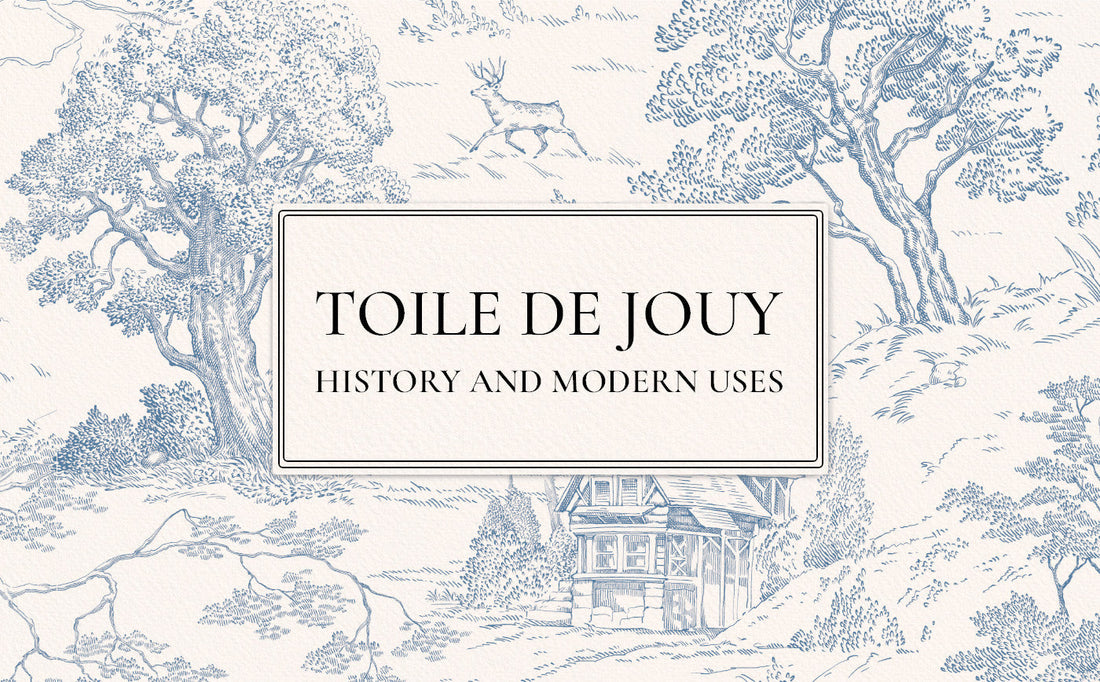Toile de Jouy: History and Modern Uses
Posted by Katsiaryna Prakopyeva on
The toile pattern has a long history in textiles and a clear place in modern interiors. This quick guide explains what it is, where it came from, and how to choose the right toile pattern without falling for low quality AI files.
What is a toile pattern?
A toile pattern is a repeating scenic print. It shows small pictures: villages, gardens, myths, drawn with fine, engraved lines. Most toiles use one ink on a light background. Over time, it became a classic and is now appreciated by major design houses and brands.
Pronunciation. toile = “twahl” (one syllable). toile de Jouy = “twahl duh zhwee”. In French, toile means “cloth”.
A short history of Toile de Jouy

Toile de Jouy began in the late 1700s in Jouy‑en‑Josas, near Versailles. In 1760, Christophe‑Philippe Oberkampf opened a textile factory there. The works later earned the title Manufacture Royale. Artists such as Jean‑Baptiste Huet drew the scenes. New copper‑plate printing, and later copper rollers, made large and shaded images possible. The style moved from fabric to wallpaper, and then across Europe. Themes of the time included: country life, allegories, scenes of distant places, and even hot‑air balloons.
How to recognize a toile pattern

To recognize a toile pattern, look for small story scenes with figures, wreaths and medal shapes, and simple buildings or landscape details. Most designs use one ink on a light ground such as ivory. Some reverse this and print light ink on a dark ground. The drawing should feel like an old engraving, with clean contours and crisp crosshatching throughout.
Where we use toile today

Home: wallpaper (feature walls, powder rooms), drapery, upholstery, bedding, shower curtains.
Fashion: popular uses include dresses, skirts, blouses, scarves, and summer sets. Jackets and totes keep the look in daily wear.
Branding & stationery: wedding suites including invitations, save the dates, RSVP and detail cards, envelope liners, belly bands, wax seals, place cards, programs, menus, gift wrap, boxes.
Digital & web: site backgrounds, packaging mockups, Canva layouts; downloadable tiles let you recolor and scale without quality loss.
Designers and brands associated with toile
Dior toile de Jouy / Dior pattern. The house of Dior helped bring toile back to fashion. You can see it on the Book Tote, scarves, and home lines.
Heritage interiors houses. Examples include Pierre Frey (Le Manach re‑editions), Manuel Canovas (bold color), and Cole & Son (toile wallpapers).
Where to find toile patterns
Physical products, ready to install or wear: fabric showrooms and wallpaper houses. Order swatches first. Retailers also stock off‑the‑shelf items like toile pattern fabric by the meter, toile wallpaper, bedding, and curtains.
Digital patterns for print and design workflows:
-
Ekaproeka — hand‑drawn, engraving‑style toile patterns with clear tile sizes, and commercial‑use licenses. Optimized for stationery, packaging, and textile mockups.
-
Curated marketplaces (Etsy, Creative Market, Spoonflower) — useful breadth, but quality and licensing vary; vet the tile and license carefully (see checklist below).
AI-generated toile: pros and cons
Pros. AI can help with quick ideas, mood boards, and trying colorways.
Cons. Many files are not seamless and scenes drift at the edges. Lines can look broken or blurry. Rights are often unclear. Sellers may skip key details such as tile size, DPI, and license terms.
For final work, choose hand drawn or vector tiles that show a clean repeat and list the tile size, DPI, and a clear license.
Digital toile buying checklist
Before you buy or download any toile de Jouy pattern file:
-
License clarity
– Personal vs. commercial use; allowed product categories.
– POD allowances and unit caps.
– Restrictions on resale of the file or “as‑is” patterns.
-
Tile & resolution
– Exact tile size (px and inches) and 300 DPI minimum for print.
– Recommended scale (“1 tile ≈ 12 in on fabric at 300 dpi,” etc.).
-
Formats & editability
– Flat PNG/JPG for quick use; AI/PSD/SVG for recolors or motif edits.
-
Seamless proof
– Supplied tile plus mockups showing vertical/horizontal joins without breaks.
– Zoomed sample to verify line sharpness and crosshatching integrity.
-
Support
– License PDF, usage notes, and a contact for custom recolors or motif swaps.
Conclusion: Why toile matters today
Toile mixes picture scenes with repeat patterns. It feels classic and modern at the same time. You can see it in museums and in today’s homes. For the best results, buy from makers who show clear repeats, sharp lines. Visit ekaproeka.com for high quality digital patterns.